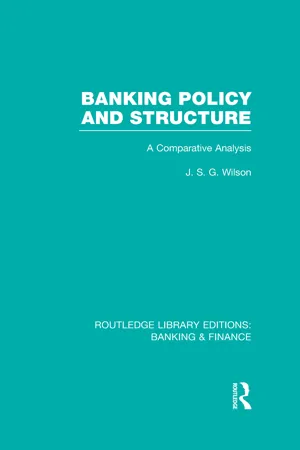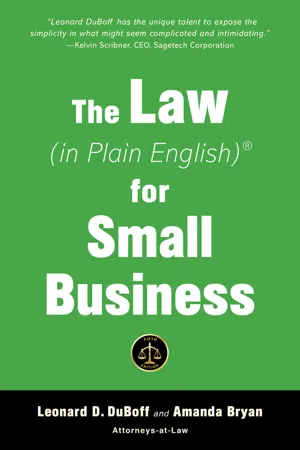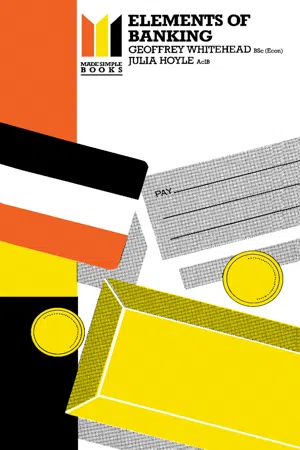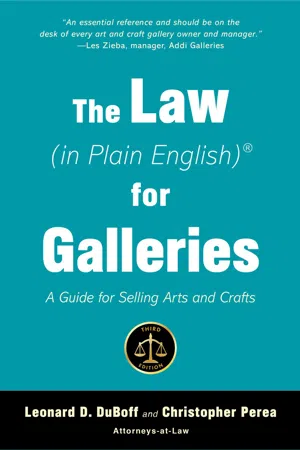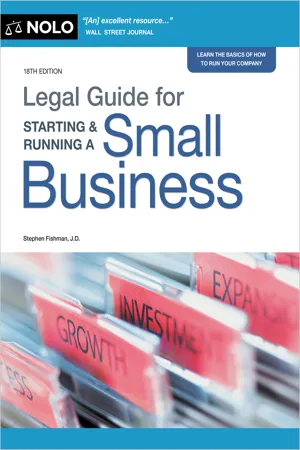Business
Bank Loans
Bank loans are funds provided by financial institutions to businesses for various purposes, such as expansion, working capital, or equipment purchase. These loans typically involve an agreement on repayment terms, interest rates, and collateral. Businesses often seek bank loans to finance their operations and investments, and the terms of the loan can vary based on the creditworthiness and financial stability of the business.
Written by Perlego with AI-assistance
12 Key excerpts on "Bank Loans"
- eBook - ePub
Banking Policy and Structure (RLE Banking & Finance)
A Comparative Analysis
- J Wilson(Author)
- 2012(Publication Date)
- Routledge(Publisher)
6THE BUSINESS OF BANKINGIn its fundamentals, banking business is very similar the world over. Yet there are some significant differences, and the attempt to explain the reasons for these variations in emphasis (or, it may be, departures from principle) therefore warrants our attention.A banker is a dealer in money and credit. The business of banking consists of borrowing and lending. As in other businesses, it is necessary to base one's trading on capital, but it is sometimes surprising, in those countries where banking is accepted as commonplace and taken for granted, how little of their own capital banks do in fact employ in relation to the total volume of their transactions.The bulk of the resources employed by a modern banker consists of borrowed moneys – largely deposits – which are lent out as profitably as is consistent with safety. Bankers are not in the business for the good of their health and they are therefore anxious to make as large a profit as they can. At the same time, they must never forget that the bulk of their resources consists of deposits, that a large proportion of these is repayable on demand, and the remainder often at short notice. They must in consequence hold part of their assets in cash in order to meet claims for payment on demand, and a proportion of the rest of their assets in forms that can be quickly converted, without significant loss, into cash.For the rest, practice varies a little. British bankers have long maintained that for the most part loans should be short-term in character and, in theory, repayable on demand, as is much of the money which the bankers themselves have borrowed, though admittedly this principle is often more honoured in the breach than in the observance and a proportion of their loans has long been at least medium-term in character. Latterly, this fact has been recognised by defining such accommodation as ‘term loans’. In other countries, lending has at times been surprisingly long-term and it will be our purpose to examine the origins of this rather different attitude to bank lending and the ways in which it is possible to pursue such a policy, while still retaining the main link with the canons of orthodox banking. - Leonard D. DuBoff, Amanda Bryan(Authors)
- 2019(Publication Date)
- Allworth(Publisher)
Intermediate-term loans, which require payment in between one and five years, and long-term loans, which extend payments over ten or even fifteen years, are more appropriate for purchases of fixed assets. Repayment on the loans is expected to be made not from the sale of these assets but from the earnings generated by the company’s ongoing use of them. Those assets produce income at a much slower rate, hence the bank’s willingness to allow repayment over a longer period. Bear in mind that commercial lenders are interested in offering funds to successful businesses in need of additional capital to expand and increase profitability. They are not particularly inclined to make loans to businesses that need the money to pay off existing debts.Depending upon your credit reputation, short-term loans may be available with or without security. It is more likely that long-term loans will require adequate security (which may include securing the asset to be acquired) and necessitate a pledge of personal, as well as business, assets.Loans that are characterized as lines of credit basically provide the business with the opportunity to borrow up to a specified amount at any given time. This can be used to facilitate purchases, help pay salaries when the business is experiencing cash flow problems, or the like. A line of credit is typically available on a long-term basis. Most lenders require the line to be paid off at least once a year, even though the money can be borrowed again immediately thereafter.The term of the loan is an important legal obligation that your business will accept and could include modifications that restrict early payoff or trigger termination upon a certain event. Considerations of this kind could entice a financial institution to accept a certain payment term, but it is important that you understand what each proposed modification may mean for your business.REPAYMENTWhen and how the loan will be repaid is closely associated with the questions of how much money is needed and for what purpose. The banker will use judgment and professional experience to assess your business ability and the likelihood of your future success. The banker will want to know whether or not the proposed use of the borrowed funds justifies the repayment schedule requested. As the borrower, you must be able to demonstrate that the cash flow anticipated from the proceeds of the loan will be adequate to meet the repayment terms if the loan is granted. As mentioned above, repayment may be restricted or triggered by certain events. Contemplating a provision of this kind may be a useful negotiating tool, but if you propose such a term, be prepared to demonstrate how the business will deal with such an event.- eBook - PDF
- Jeff Madura(Author)
- 2020(Publication Date)
- Cengage Learning EMEA(Publisher)
These so-called lender liability suits have been especially prevalent in the farming, grocery, clothing, and oil industries. Copyright 2021 Cengage Learning. All Rights Reserved. May not be copied, scanned, or duplicated, in whole or in part. Due to electronic rights, some third party content may be suppressed from the eBook and/or eChapter(s). Editorial review has deemed that any suppressed content does not materially affect the overall learning experience. Cengage Learning reserves the right to remove additional content at any time if subsequent rights restrictions require it. Chapter 17: Commercial Bank Operations 453 Volume of Business Loans The volume of business loans provided by commercial banks changes over time in response to economic conditions. When the economy is strong, businesses are more willing to finance expansion. When economic conditions are weak, businesses defer expansion plans and, therefore, do not need as much financing. As an example, economic growth increased during the 2004–2006 period, resulting in a major increase in business loans provided by banks. In contrast, during the credit crisis of 2008–2009, the volume of business loans decreased. Types of Consumer Loans Commercial banks may provide individuals with installment loans to finance purchases of cars and household products. These loans require the borrowers to make periodic payments over time. Banks may also provide credit cards to consumers. Credit card holders are assigned a maximum limit based on their income and credit history, and a fixed annual fee may be charged to maintain the account. This service often involves an agreement with VISA or MasterCard. If consumers pay off the balance each month, they usually are not charged interest. Bank rates on credit card balances are sometimes nearly double the rate charged on business loans. - eBook - PDF
Financial Institutions
Markets and Money
- David S. Kidwell, David W. Blackwell, David A. Whidbee, Richard W. Sias(Authors)
- 2020(Publication Date)
- Wiley(Publisher)
With a fixed‐rate loan, the bank assumes all of the interest rate risk. Borrowers shift to floating‐ rate loans, however, if they are offered sufficient inducement in the form of a lower initial interest rate on the floating‐rate loan. COMMERCIAL AND INDUSTRIAL LOANS As shown in Exhibit 13.7, loans to commercial and industrial firms constitute 12 percent of total assets. Most are short‐term loans with maturities of less than 1 year. The type of loans made by a bank reflects the composition of the bank’s customers. Consequently, business lending is typically more important to large banks than to small retail banks. There are three basic types of business loans, depending on the borrower’s need for funds and source of repayment. A bridge loan supplies cash for a specific transaction with repayment coming from an identifiable cash flow. Usually, the purpose of the loan and the source of repayment are related; hence, the term bridge loan. For example, an advertising company enters into a contract to produce a TV commercial for the Ford Motor Company. The total contract is for $850,000; however, the advertising company needs approximately $400,000 in financing to produce the commercial. The loan is a bridge loan because it sup- ports a specific transaction (making the commercial) and the source of repayment is identifi- able (completing the commercial). A seasonal loan provides term financing to take care of temporary discrepancies between business revenues and expenses that are the result of the manufacturing or sales cycle of a business. For example, a retail business may borrow money to build inventory in anticipation of heavy Christmas sales and may expect to repay it after the new year begins. The uncertainty in this type of loan is whether the inventory can be sold for a price that covers the loan. Long‐term asset loans are loans that finance the acquisition of an asset or assets. - Leonard D. DuBoff, Rudolph Lopez(Authors)
- 2022(Publication Date)
- Allworth(Publisher)
CHAPTER 4Borrowing from BanksCommercial loans can be a valuable source of needed capital for qualified business borrowers. Small businesses sometimes seek loans from institutional lenders, such as credit unions, insurance companies, and pension trusts. Unfortunately, institutional lenders other than banks will rarely deal with small businesses, particularly when the potential borrower does not have an extensive track record. It is for this reason the focus of this chapter is on bank lending. You should, however, consider these other sources of funds when seeking a loan. Most institutional lenders follow the same procedures as banks and demand the same type of information.Lending policies vary dramatically from institution to institution. You should talk to several banks to determine which might be likely to lend to your business and which have the most favorable loan terms. While lenders, by nature, are conservative in their lending policies, you may discover some to be more flexible than others. To save time and increase the chances of loan approval, it makes sense to first approach those banks that are most likely to view your proposal favorably and whose lending criteria you feel you can meet.You should not necessarily limit your search for a loan to your community. A statewide, regional, or even national search may be necessary before you find the right combination of willing lender and favorable terms. With the Internet, this is not as difficult as it once was.In Plain EnglishUsing your credit card as a source of financing is not a good idea, except in the most extreme cases. Interest rates are high and the terms are generally not good for business planning. You must also personally guarantee any business credit card.After having shopped the marketplace and decided on a particular bank, you will be ready for the next step—preparing the loan proposal. The importance of being properly prepared before taking this critical step cannot be overemphasized. Loan officers are not likely to be impressed by a hastily prepared application containing vague, incomplete information and unsubstantiated claims. Many loan requests are doomed at this early stage because ill-prepared applicants failed to adequately present themselves and their businesses to the lender even though the proposed ventures are, in fact, sound.- eBook - PDF
Elements of Banking
Made Simple
- Julia Hoyle, Geoffrey Whitehead(Authors)
- 2014(Publication Date)
- Butterworth-Heinemann(Publisher)
12.5 Other advances There are a number of other situations where advances will be made to assist customers who are in difficult circumstances of a non-routine nature. Thus bridging loans assist those engaged in the conveyancing of property where events cannot quite be synchronized. Executors of wills or those granted letters of administration may need assistance in paying taxes due, such as VAT, income tax and inheritance tax. The captains of ships some- Bank lending 161 times need to be helped to pay for repairs or other expenses against a security known as a bottomry bond. Such matters are not really ap-propriate for the present book and must be the subject of more specialized studies at a higher level. 12.6 Rapid revision: bank lending 1 The aim of banks is to make profits for their shareholders. Bank lending is the most profitable activity for banks, and about 75 per cent of bank assets are advances to customers. Even so we can only lend to 'eligible' borrowers. 2 Eligible borrowers are those to whom lending is justified because they wish to borrow for viable projects which will yield sufficient extra profits to finance the interest and repayment of the loan. They must also have a record of integrity. Alternatively they may be borrowers in sound em-ployment, earning a good salary and with a good record of integrity. 3 In assessing proposals to borrow some projects are easy to evaluate (car purchase for example) but others may be involved and envisage long-term commitments by the bank. Managers must study such schemes carefully so that they understand the project, and on-site inspection may be necessary. 4 The amount of the loan, the yield from the new project, the repayment schedule and the contribution to be made from the customer's own re-sources are all important elements in the decision to sanction a loan. If the loan is to be used for working capital a cash budget is desirable. - eBook - ePub
Raising Capital
Get the Money You Need to Grow Your Business
- Andrew Sherman(Author)
- 2012(Publication Date)
- AMACOM(Publisher)
These loans are almost always secured not only by the assets being purchased with the loan proceeds, but also by the company’s other assets, such as inventory, accounts receivable, equipment, and real estate. This arrangement usually calls for a loan agreement, which typically includes restrictive covenants that govern the company’s operation and management during the term of the loan. The covenants are designed to protect the lender’s interests and to ensure that all payments are made on time, before any dividends, employee bonuses, or noncritical expenses are paid. Long-Term Loans. These are generally extended for specific, highly secured transactions, such as the purchase of real estate or a multiuse business facility. When such a purchase is being made, a lender will consider extending a long-term loan to a small company for 65 to 80 percent of the appraised value of the land or building. (As a general rule, commercial banks don’t provide long-term financing to small businesses. The risk of market fluctuations and business failure over a 10- or 20-year term is simply too high for a commercial lender to feel comfortable with such a loan.) Letters of Credit. These are issued by commercial banks solely in connection with international sales transactions, to expedite the shipping and payment process for those transactions. In a typical letter-of-credit scenario, the seller demands that payment be made in the form of a letter of credit, and the buyer must then make arrangements with its bank to issue the letter of credit - eBook - ePub
The Bank Credit Analysis Handbook
A Guide for Analysts, Bankers and Investors
- Jonathan Golin, Philippe Delhaise(Authors)
- 2013(Publication Date)
- Wiley(Publisher)
Chapter 3
The Business of Banking
Banks are still preeminent in the financial system . . . [and ] are vital to economic activity, because they reallocate money, or credit, from savers, who have a temporary surplus of it, to borrowers, who can make better use of it . . . [and by ] collaborating to clear payments, they help individuals and firms fulfill transactions.Banking is a business like any other—a raw material (in this case money) goes into the process we call banking, and hopefully, a profit . . . comes out . . . the other end.—The Economist1—Howard Palmer2A bank is a place that will lend you money if you can prove that you don’t need it.—Bob Hope, comedian and actor (1903–2003)3Banking, at its core, is a simple business. Banks transform the savings of many individual depositors into credit finance. One of several types of financial intermediaries —a category that also includes insurance companies, securities underwriters and brokers , and investment managers , a bank, as do these institutions,4 functions as a conduit between those with funds to deposit or invest and those in need of funds. Classically, in banking, intermediation occurs when a bank accepts deposits from those with surplus funds (depositors) and lends the same funds to entities in need of funds (borrowers).5 That is, traditionally, banks borrow money from depositors to lend to those who borrow money from it. Although banks perform other functions besides taking deposits and advancing loans, this core intermediation function remains at the heart of commercial banking.6BANKS AS INTERMEDIARIESBanks intermediate between savers and borrowers by taking deposits from those with surplus funds (depositors) and lending those funds to entities in need of funds.7How Banks Add Value
Through their deposit-taking and lending operations, banks add value for their customers by offering terms that are respectively attractive to both depositors and borrowers. Banks are able to add value to both depositors and borrowers through their ability to: - eBook - ePub
The Law (in Plain English) for Galleries
A Guide for Selling Arts and Crafts
- Leonard D. DuBoff, Christopher Perea(Authors)
- 2020(Publication Date)
- Allworth(Publisher)
CHAPTER 4 Borrowing from BanksCommercial loans can be a valuable source of needed capital for qualified gallery business borrowers. Small businesses sometimes seek loans from institutional lenders, such as credit unions, insurance companies, and pension trusts. Unfortunately, institutional lenders other than banks will rarely deal with small businesses, particularly when the potential borrower does not have an extensive track record. It is for this reason the focus of this chapter is on bank lending. You should, however, consider these other sources of funds when seeking a loan. Most institutional lenders follow the same procedures as banks and demand the same type of information.Lending policies vary dramatically from institution to institution. You should talk to several banks to determine which might be likely to lend to your gallery business and which have the most favorable loan terms. While lenders, by nature, are conservative in their lending policies, you may discover some to be more flexible than others. To save time and increase the chances of loan approval, it makes sense to first approach those banks that are most likely to view your proposal favorably and whose lending criteria you feel you can meet.You should not necessarily limit your search for a loan to your community. A statewide, regional, or even national search may be necessary before you find the right combination of willing lender and favorable terms. With the Internet, this is not as difficult as it once was.IN PLAIN ENGLISHusing your credit card as a source of financing is not a good idea, except in the most extreme cases. Interest rates are high and the terms are generally not good for business planning. You must also personally guarantee any business credit card.After having shopped the marketplace and decided on a particular bank, you will be ready for the next step—preparing the loan proposal. The importance of being properly prepared before taking this critical step cannot be overemphasized. Loan officers are not likely to be impressed by a hastily prepared application containing vague, incomplete information and unsubstantiated claims. Many loan requests are doomed at this early stage because ill-prepared applicants fail to adequately present themselves and their businesses to the lender even though the proposed ventures are, in fact, sound. - Hans Landström(Author)
- 2017(Publication Date)
- Edward Elgar Publishing(Publisher)
+ Bank Loans increase the availability of more credits as bank relationship develops, but also serve as a signal to other resource providers. + Does not require entrepreneurs to give up any ownership of the venture. The entrepreneur retains control of the venture. + In many countries the interest is tax-deductible in the business income taxes. + Bank debt is considered to be a cheap source of external finance – banks only require interest on their loans and do not expect to share the value creation. + Provides a less capital- intensive funding option for equipment rather than purchasing outright. + Facilitates cash flow and reduces short- term balance sheet risk. + Maintains up-to-date equipment. + Enhanced by corporate tax considerations (which often allow firms to reduce trading profits). + Guarantees not required – security is on assets purchased. Disadvantages − Banks are conservative in their lending policies. − Obligation to return the loan with interest, which makes it an expensive and liquidity stressful form of finance, i.e., good cash flow required to meet interest and capital repayments. − Usually secured against business or personal assets, i.e., collateral or personal guarantees necessary to secure loans. − Debt repayment can vary depending on changes in interest rate. − Failure to repay the loan may lead to liquidation of the venture. − Expensive compared to interest rates charged on loans. – Requires adequate cash flow to meet regular payments. − May reduce the ability to raise other forms of finance as the discounted invoice will no longer be available as security. − Factoring will cause some losses in order to bring forward the cash flow. DEBT CAPITAL FINANCE 131 6.3.1 Problems and solutions in bank lending to entrepreneurial ventures Bank financing to entrepreneurial ventures is often characterized as an ‘opaque market’ that includes a lot of imperfect information (Berger and Udell, 1998).- Available until 31 May |Learn more
- Stephen Fishman(Author)
- 2023(Publication Date)
- NOLO(Publisher)
But you might also need to seek money from outside sources, so it’s important to understand the two main categories of such funding and the differences between them. One category is loans and the other is equity investments. Loans As you know, a loan is based on a simple idea: Someone gives you money and you promise to pay it back—usually with interest. Because you must pay back the lender whether your business is a fabulous success or a miserable failure, the entire risk of your new enterprise is placed squarely on your shoulders. Of course, nothing in business—or in life, for that matter—is without risk. Nevertheless, a commercial lender will be unwilling to lend you money if the odds of your repaying the money look low. And to help keep the risk down, a lender will very likely ask for “security” for the loan—for example, a mortgage on your house so that the lender can take and sell your house if you don’t keep up your loan payments. But as compared to selling a portion of your business to investors, there’s an obvious plus side to borrowing money: If your business succeeds as you hope and you pay back the lender as promised, you reap all future profits. There’s no need to share them. In short, if you’re confident about your business’s prospects and you have the opportunity to borrow money, a loan is a more attractive source of money than getting it from an equity investor who will own a piece of your business and receive a share of the profits. Again, the downside is that if the business fails and you’ve personally guaranteed the loan, you’ll have to repay it. By contrast, you don’t have to repay equity investors if the business goes under. 142 | LEGAL GUIDE FOR STARTING & RUNNING A SMALL BUSINESS Loans are so common that you probably are familiar with the mechanics, but nevertheless it makes sense to review the basics. - eBook - ePub
- Leonard D. DuBoff(Author)
- 1999(Publication Date)
- Allworth(Publisher)
4BORROWING FROM BANKS
C ommercial loans can be a valuable source of capital for qualified business borrowers. Lending policies vary dramatically from institution to institution, and although lenders by nature are conservative, some may be more flexible than others. You should talk to several banks to determine which ones would be more likely to lend to your business under the most favorable terms. To save time and increase the chances of loan approval, approach those banks first. (Your search should not be limited to your community. You might have to conduct a statewide, regional, or even national search before you find the right combination of willing lender and beneficial terms.) Using your credit card as a source of financing is not a good idea except in the most extreme cases. Interest rates are high and the terms are generally not good for business planning.Once you have shopped the marketplace and selected a bank or banks, you are ready for the next step: preparing the loan proposal. It is very important to be properly prepared before taking this critical step. Loan officers are not likely to be impressed by a hastily prepared application containing vague, incomplete information and unsubstantiated claims. Many loan requests are doomed at this early stage because ill-prepared applicants do not present themselves and their businesses adequately to the lender, even though the proposed ventures are, in fact, sound.THE LOAN PROPOSAL
To avoid an unexpected rejection, it is essential to know the bank’s lending policy and to follow its procedures for a loan application. At a minimum, you should be prepared to satisfactorily address each of the following questions when applying for a loan. The lender’s decision will be based on your answers. The ability to obtain money when you need it may be as important to the operation of your business as having a good location and a rich portfolio of art or crafts. Before an institution will agree to lend you money, the loan officer must be satisfied that you and your business constitute a good risk—that is, that you are creditworthy. There are several criteria:
Index pages curate the most relevant extracts from our library of academic textbooks. They’ve been created using an in-house natural language model (NLM), each adding context and meaning to key research topics.
